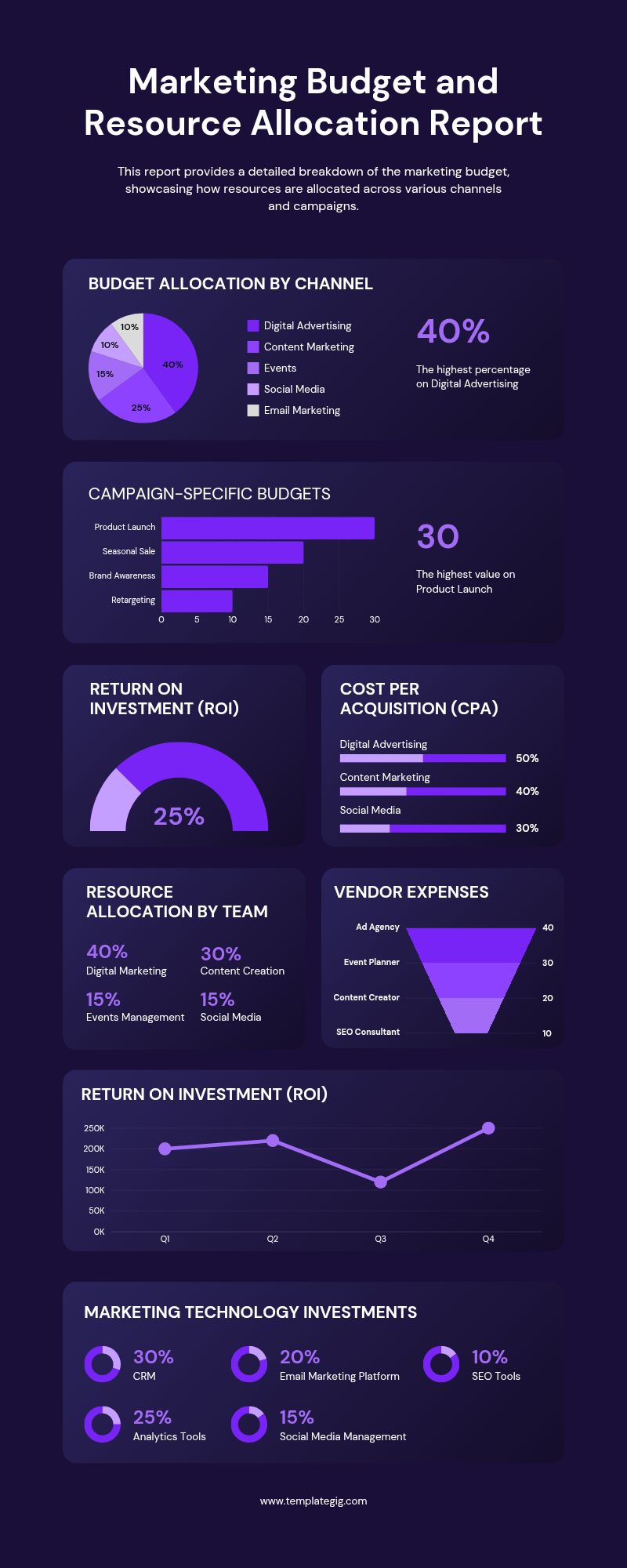
Crafting a Winning Marketing Budget: A Guide to Resource Allocation
A well-structured marketing budget is the bedrock of any successful campaign. It’s not just about numbers; it’s about strategically allocating resources to achieve specific marketing goals and maximize return on investment (ROI). This article delves into the process of creating a comprehensive marketing budget and resource allocation report, equipping you with the tools to optimize your marketing efforts.

1. Define Your Marketing Objectives:

The foundation of any budget lies in clearly defining your marketing objectives. What do you aim to achieve? Increase brand awareness? Drive website traffic? Generate leads? Boost sales? Each objective should be specific, measurable, achievable, relevant, and time-bound (SMART).

2. Conduct Market Research and Competitive Analysis:
Before diving into numbers, gain a deep understanding of your target audience, market trends, and competitor strategies. Analyze market share, customer demographics, and competitor spending to inform your budget allocation.

3. Determine Your Marketing Channels:
Identify the most effective channels to reach your target audience. Consider options like social media, search engine optimization (SEO), content marketing, email marketing, paid advertising, public relations, events, and partnerships.

4. Estimate Costs for Each Channel:
Based on your chosen channels, research and estimate the associated costs. For example, paid advertising requires setting budgets for platforms like Google Ads or Facebook Ads. Content marketing involves costs for content creation, distribution, and promotion.

5. Allocate Budget Based on ROI Potential:
Prioritize channels with the highest potential for ROI. Allocate larger portions of your budget to channels that have proven successful in the past or are expected to deliver significant returns.

6. Build a Detailed Budget Breakdown:
Create a detailed budget breakdown that outlines the specific costs for each channel. This should include:
* Fixed Costs: These are recurring costs, such as salaries, software subscriptions, and office rent.
* Variable Costs: These fluctuate based on usage, such as advertising expenses, content creation, and event costs.
* Contingency Funds: Allocate a portion of your budget for unexpected expenses or opportunities.

7. Track and Analyze Performance:
Regularly track the performance of your marketing campaigns and analyze the data to identify areas for improvement. Adjust your budget allocation based on insights gained from data analysis.
8. Create a Resource Allocation Report:
A resource allocation report outlines how your budget is distributed across different marketing activities. It should include:
* Channel Breakdown: Detail the budget allocation for each channel.
* Activity Breakdown: Specify the budget allocated to specific activities within each channel, such as content creation, advertising campaigns, or event planning.
* Timeline: Indicate the budget allocation for different periods, such as quarterly or monthly.
* Key Performance Indicators (KPIs): Define the metrics used to measure the success of each activity, such as website traffic, leads generated, or sales conversions.
* Responsible Parties: Assign individuals or teams responsible for managing each budget allocation.
9. Regularly Review and Update:
The marketing landscape is constantly evolving. Regularly review your budget and resource allocation report, making adjustments as needed based on market changes, performance data, and emerging opportunities.
Example Resource Allocation Report:
| Channel | Activity | Budget Allocation | Timeline | KPIs | Responsible Party |
|—|—|—|—|—|—|
| Social Media | Content Creation | $5,000 | Q1 2024 | Reach, Engagement, Website Traffic | Social Media Manager |
| SEO | Keyword Research & Optimization | $3,000 | Q1 2024 | Organic Traffic, Website Rankings | SEO Specialist |
| Email Marketing | Newsletter Design & Distribution | $2,000 | Q1 2024 | Open Rates, Click-Through Rates, Conversions | Email Marketing Manager |
| Paid Advertising | Google Ads Campaign | $4,000 | Q1 2024 | Clicks, Conversions, Cost Per Acquisition (CPA) | PPC Specialist |
Conclusion:
Creating a comprehensive marketing budget and resource allocation report is crucial for maximizing ROI. By following the steps outlined above, you can ensure your marketing efforts are aligned with your business goals, enabling you to achieve success in today’s competitive marketplace.
Remember, a well-crafted budget is not a static document. It should be dynamic and responsive to changing market conditions, data insights, and evolving business objectives.






Leave a Reply